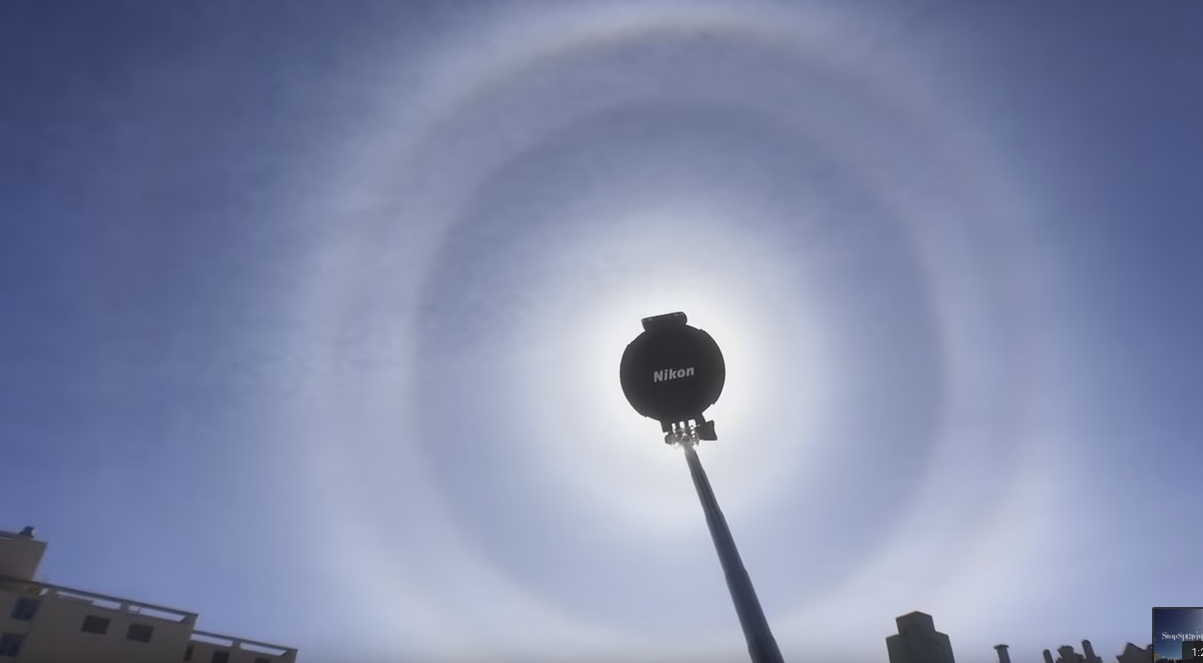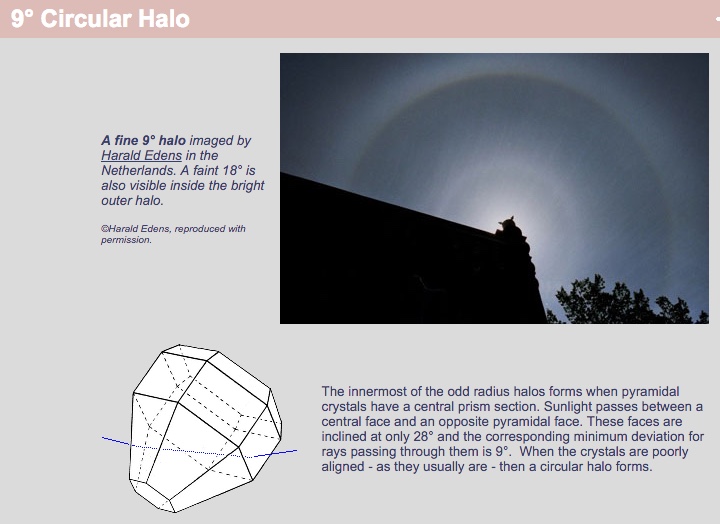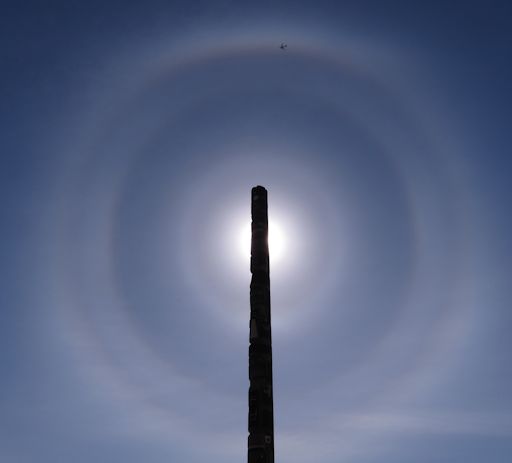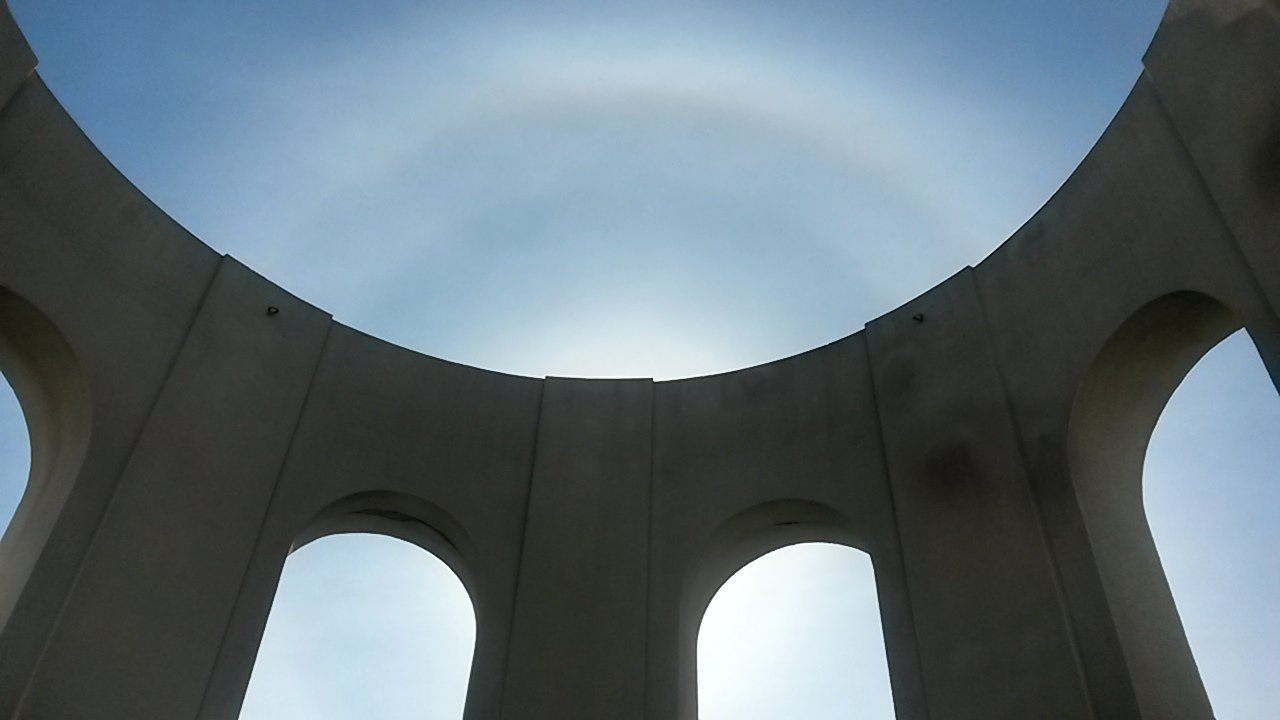You are using an out of date browser. It may not display this or other websites correctly.
You should upgrade or use an alternative browser.
You should upgrade or use an alternative browser.
Unusual Multiple Halo over San Francisco [Pyramidal Ice Crystals - "Odd Radius Halos"]
- Thread starter skephu
- Start date
Fascinating. He also posted this photo:

Detail, contrast enhanced.

It appears to be a solar corona, possible with a 22° halo in the mix. Edit, now it appears to actually be an additional halo.
http://www.atoptics.co.uk/droplets/corona.htm
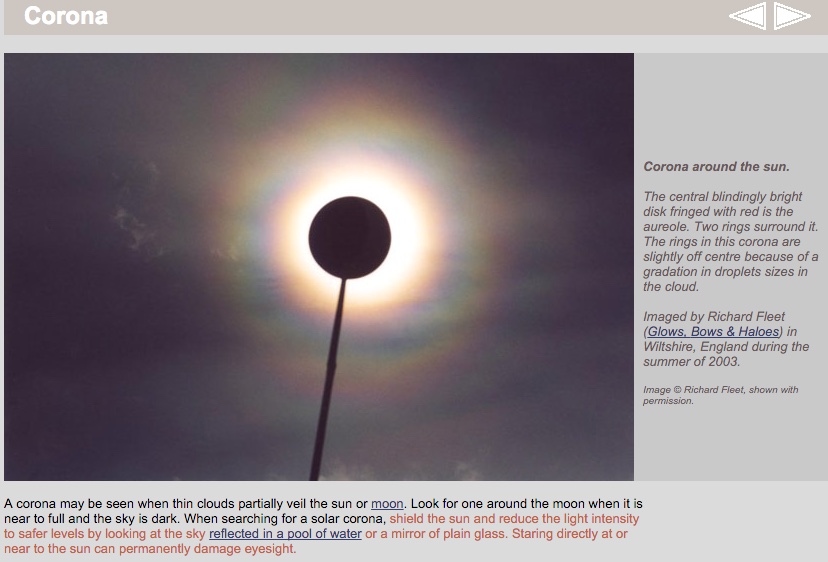
Detail, contrast enhanced.
http://www.atoptics.co.uk/droplets/corona.htm

Last edited:
skephu
Senior Member.
Oh. Do you recognize that line-shaped cloud in the photo?Fascinating. He also posted this photo:

It's the one Marin B posted in the other topic. At least it's extremely similar.
skephu
Senior Member.
Here's a heavily color-enhanced version:

I think the inner, smaller ring (or rings) may be a corona. But the two outer rings seem to be too large for that, their edges are too sharp for a corona (and the spacings and the colors don't match a corona either). One of the outer rings must be the 22-degree halo, but what's the other one? It looks like the 22-deg halo repeated. Their inner edges are reddish, as it should be for the 22-deg halo.
I think the inner, smaller ring (or rings) may be a corona. But the two outer rings seem to be too large for that, their edges are too sharp for a corona (and the spacings and the colors don't match a corona either). One of the outer rings must be the 22-degree halo, but what's the other one? It looks like the 22-deg halo repeated. Their inner edges are reddish, as it should be for the 22-deg halo.
SR1419
Senior Member.
Patrick Roddie has posted this video showing a strange double halo
he seems to conflate sundogs and halos- whilst related they are not the same thing...when I posted that they are not particularly rare- especially in winter, he deleted my post. I also asked if he really thought aluminum refracted light
Comparing to an actual 22° halo from one of Roddie's excellent time-lapses(on the left, and a section over the top right), from the same viewpoint. The indicate ring does match a 22° halo. EDIT: This seems to be inaccurate, due to camera distortion .
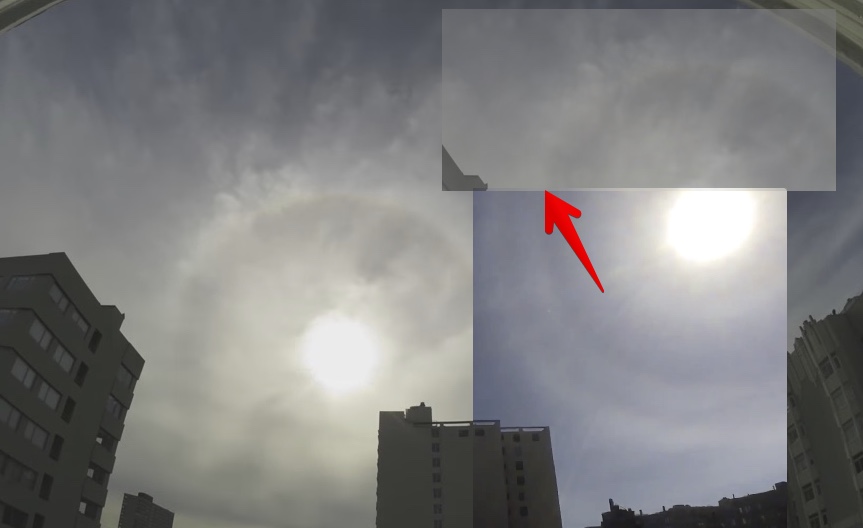
The time-lapse lens is a bit fisheye, so the buildings don't line up exactly.

The time-lapse lens is a bit fisheye, so the buildings don't line up exactly.
Last edited:
skephu
Senior Member.
Look at what I found searching for 28-degree halos:
Andrew J. Weinheimer and Charles A. Knight: Scheiner's Halo: Cubic Ice or Polycrystalline Hexagonal Ice?
J. Atmos. Sci., 44, 3304–3308.
Could it really be a Scheiner's halo along with a 22-degree halo along with a corona? If yes, that's really an extraordinary phenomenon.
Andrew J. Weinheimer and Charles A. Knight: Scheiner's Halo: Cubic Ice or Polycrystalline Hexagonal Ice?
J. Atmos. Sci., 44, 3304–3308.
A more recent description on an unlikely web site:A new explanation is proposed for the rare Scheiner's halo, observed in the sky at an angle of 28° from the sun or moon. The existing explanation invokes the presence in the atmosphere of the cubic form of ice, ice Ic. However, extensive laboratory work has not demonstrated that ice Ic can form under conditions found in the atmosphere. We point out an alternative, that polycrystals of ice Ih (the ordinary hexagonal polymorph), in which specific orientation relations exist between adjacent crystals, are another possible cause of Scheiner's halo. Polycrystals with the appropriate orientation relation are not uncommon in the atmosphere, but concentrations sufficient to produce optical effects are expected to be rare. There appears to be no decisive evidence to rule out either of these explanations.
Now if this thing has only been reported 7 times in the last 350 years, and Patrick Roddie observed it then he can really say it is incredibly rare!A rare halo around the sun or the moon sometimes appears at 28 degrees instead of 22 degrees. But don’t stay up late gazing at the full moon to see it. This halo, called Scheiner’s halo, has been reported only seven times in the last 350 years. Scientists know that such a halo could be caused by octahedral, or eight-sided crystals. What crystals could cause this 28 degree halo? The mystery was recently solved by scientists working with cubic ice. Cubic ice is an unusual form of water ice. When water is frozen at temperatures of 100 below zero it forms octahedral instead of hexagonal crystals. They used a little math to show that octahedral water crystals could cause Scheiner’s halo. Scientists are now trying to discover whether conditions in the upper atmosphere could actually form cubic ice.
Could it really be a Scheiner's halo along with a 22-degree halo along with a corona? If yes, that's really an extraordinary phenomenon.
Awesome! It looks like it is actually an additional halo, made with cubic ice! Check out the colors here.
https://www.wunderground.com/wximage/Skyywatcher88/111
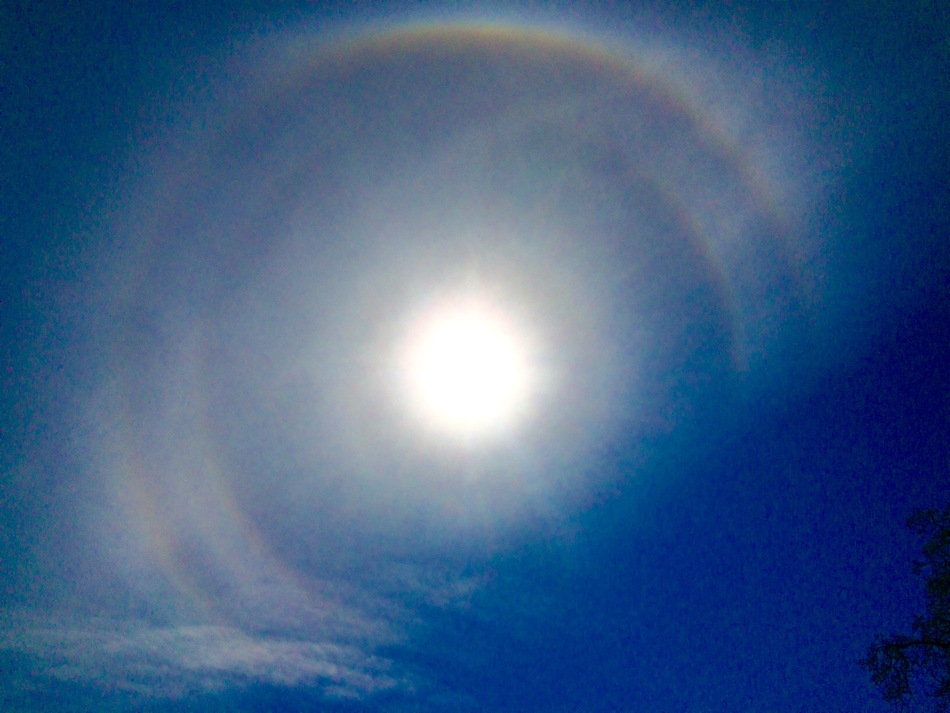
https://www.wunderground.com/wximage/Skyywatcher88/111

Double Sun Halo
Uploaded by: Skyywatcher88
Tuesday February 23, 2016
Ballico, CA (Current Weather Conditions)
Caption: I must say this is a first! Photo by Richard Sears
Camera Type: iPhone 5s
...
2. jjulian
1:23 PM GMT on February 24, 2016
I've never seen this before, pretty amazing capture, congrats!
llpj04
11:46 PM GMT on February 23, 2016
I've have never caught one like this! Have not seen many on WU either
skephu
Senior Member.
I just found this: World Database of rare halos
From this page it turns out that there are lots of halos:
6, 9, 12, 18, 20, 23, 24, 28, 35-degree halos.
Unfortunately most of the image links are dead on that page.
So the smaller inner rings may also be halos rather than a corona.
From this page it turns out that there are lots of halos:
6, 9, 12, 18, 20, 23, 24, 28, 35-degree halos.
Unfortunately most of the image links are dead on that page.
So the smaller inner rings may also be halos rather than a corona.
More images and comments
http://spaceweathergallery.com/indi...d=123036&PHPSESSID=nr8hai2s5q7draeqte84h2t6k6
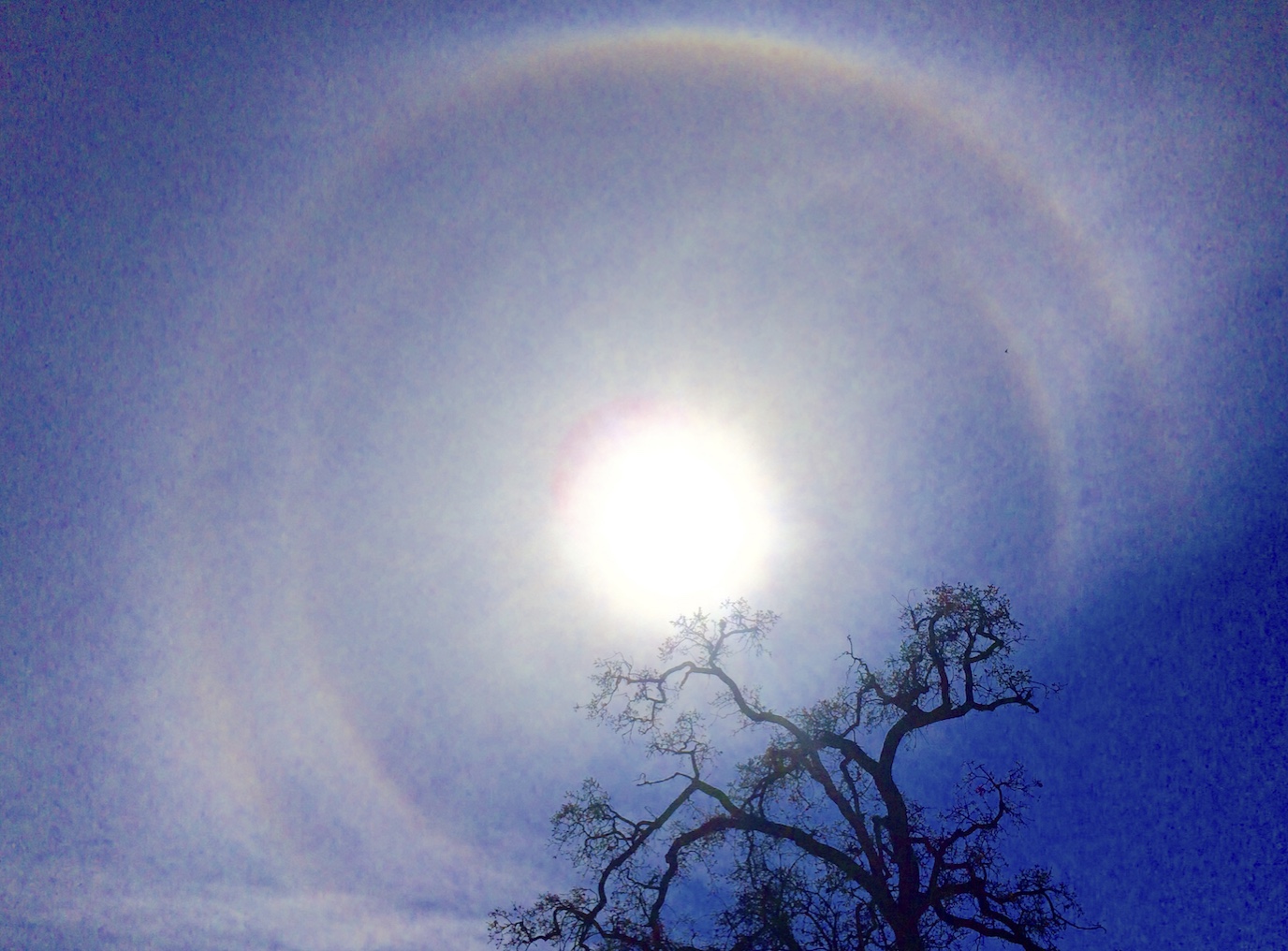
http://spaceweathergallery.com/indi...d=123036&PHPSESSID=nr8hai2s5q7draeqte84h2t6k6

Last seen 1974. Now that's "incredibly rare".Actually there were three circles around the sun, and a very, vet faint fourth one http://spaceweathergallery.com/indiv_upload.php?upload_id=123044 You may read more about your display here http://www.atoptics.co.uk/halo/pyrhalo.htm A very good catch!
Posted by mila 2016-02-23 21:38:18
Dr Terence Meaden tells me
I know this one. It is extremely rare. I was fortunate to see it in 1974. Through the medium of the Roy Met Soc magazine Weather, I found others who had seen it. They all lived in a broad band right across southern England. I was the last witness as the Cs cloud moved eastwards. Three of us wrote it up as a paper published in 1974.
I refer to the paper The concentric halo display of 14 April 1974, by E.C.W. Goldie, G.T. Meaden and Richard White. WEATHER Volume 31, 304-312 (1976). As you know the commonest halo is the 22-degree one, and the 46 halo is very infrequent.
The ones that I saw between 1840 and 1905 GMT were estimated as 9, 22, 24, and 26/27---plus also the upper arc of contact to the 22 one.
Other observers also saw haloes at 18 , 32 and 46. Twelve observers in all. Furthest east was The Hague in Holland; furthest west was me in Trowbridge. We published sketches and examined the physics of the situation. We wondered whether numerous earlier condensation trails produced the pyramidal ice crystals of the cirrus and cirrostratus clouds.
Posted by Glaznoz 2016-02-24 08:11:34
Several images here:
http://spaceweathergallery.com/indi...d=123044&PHPSESSID=nr8hai2s5q7draeqte84h2t6k6
This one being particularly awesome (cropped)
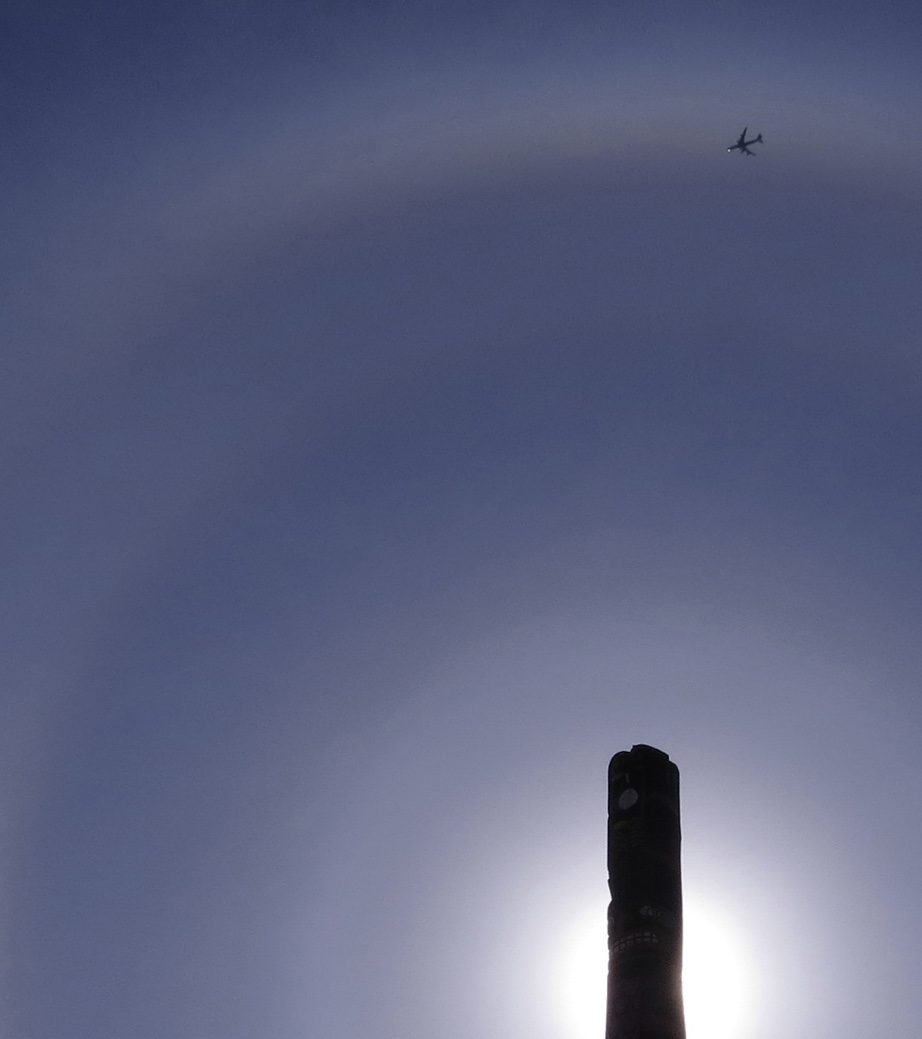
Other similar:
http://spaceweathergallery.com/indi...d=123052&PHPSESSID=nr8hai2s5q7draeqte84h2t6k6
http://spaceweathergallery.com/indi...d=123044&PHPSESSID=nr8hai2s5q7draeqte84h2t6k6
This one being particularly awesome (cropped)

Other similar:
http://spaceweathergallery.com/indi...d=123052&PHPSESSID=nr8hai2s5q7draeqte84h2t6k6
Of course with so many halos, it becomes harder to argue that it's all just ice crystals.
Well, except that this is unlikely to be seen again in the next several years. So unless chemtrails have only been sprayed on this one day, then it's all ice crystals.
And of course these halos are explained by ice crystals, just odd shaped ones.
Spectrar Ghost
Senior Member.
Well, except that this is unlikely to be seen again in the next several years. So unless chemtrails have only been sprayed on this one day, then it's all ice crystals.
And of course these halos are explained by ice crystals, just odd shaped ones.
This is where I really get hung up on 'chemtrails'. By choosing to ignore the science, one misses out on the truly strange and beautiful parts of meteorology.
The real explanations of phenomena like this are so much more interesting than arguing over pylon drains and ballast barrels.
Couple more photos of the multi-halo from the chemtrail people:
https://www.facebook.com/photo.php?fbid=1013019485411397&set=p.1013019485411397&type=3&permPage=1
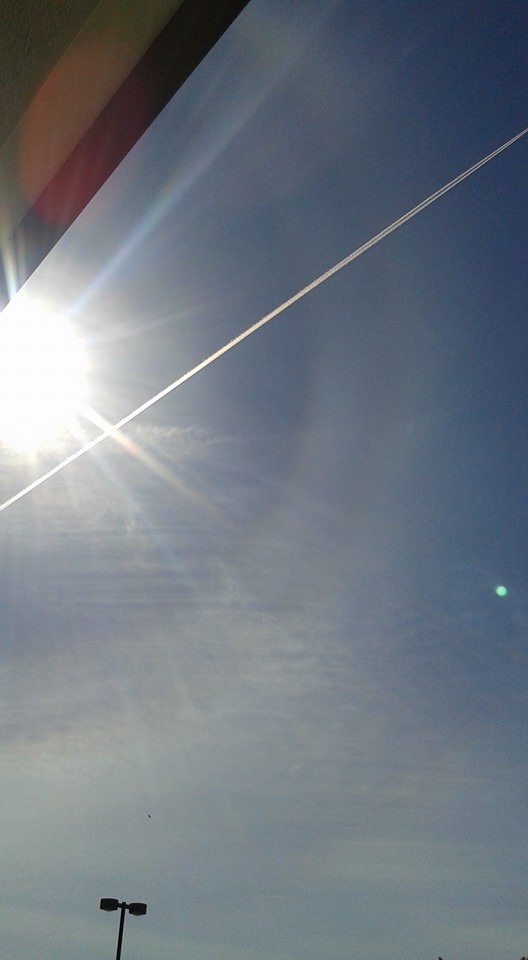
https://www.facebook.com/photo.php?fbid=1013019668744712&set=p.1013019668744712&type=3&theater
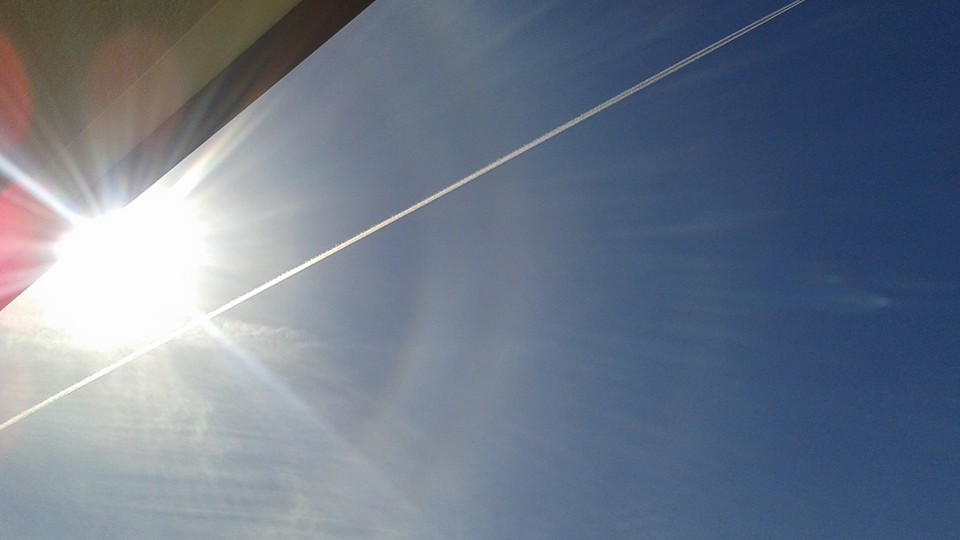
https://www.facebook.com/photo.php?fbid=1047069135336191&set=p.1047069135336191&type=3&theater
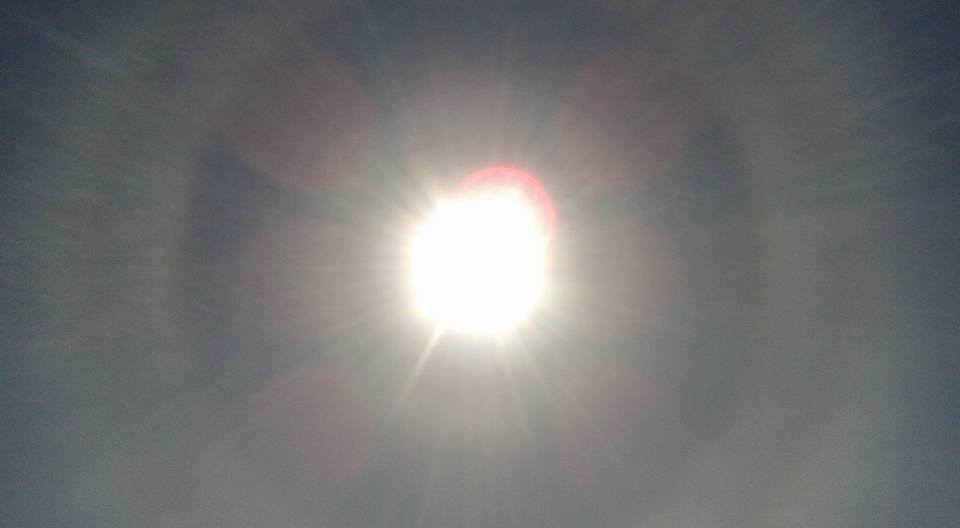
https://www.facebook.com/photo.php?fbid=1013019485411397&set=p.1013019485411397&type=3&permPage=1

https://www.facebook.com/photo.php?fbid=1013019668744712&set=p.1013019668744712&type=3&theater

https://www.facebook.com/photo.php?fbid=1047069135336191&set=p.1047069135336191&type=3&theater

Dan Page
Senior Member.
This phenomena was unusual enough to make it into todays www.spaceweather.com and explained as "tiny pyramids of ice", so it looks like you all were mostly spot on, and again the chemmies are a little off the mark.
PYRAMIDS OVER CALIFORNIA: People who pay attention to the daytime sky often notice a luminous ring surrounding the sun. It's called an ice halo, caused by sunlight shining through ice crystals in wispy cirrus clouds. On Feb. 23rd, San Francisco photographer Mila Zinkova looked up and saw not one, but "four wondrous circles around the sun." She quickly moved into the shadow of a totem pole and snapped this picture:
About 100 miles away in Ballico, California, Richard Sears witnessed a similar display. "I've been photographing sun halos here in California for years. I must say, this is the first," says Sears. "I wonder what is going on here?"
The answer: The air was filled with tiny pyramids of ice.
Atmospheric optics expert Les Cowley explains: "These are magnificent and rare displays of pyramidal crystal halos. Ordinary halos are made by six-sidedcolumn- or plate-shaped crystals in high and cold cirrus clouds. Over California their ends were capped with pyramids. The pyramids always have fixed angles set by planes of atoms in the ice. Light passing through them form 'odd radius halos' 9, 18, 20, 23, 24 and 35 degrees from the sun. On Mila's image I can see a bright 9 degree ring, an 18 degree one and then a clump of twenty-something radius halos."
skephu
Senior Member.
That's a different assessment from what we arrived at. From Mick's comparison with an earlier photo by Patrick Roddie, we found that the inner outer ring is the 22° halo, and in that case the outer one must be at 28°. But if Les Cowley is right then the inner one is at 18° and the outer one should be the 22°."On Mila's image I can see a bright 9 degree ring, an 18 degree one and then a clump of twenty-something radius halos."
If we take into account the very faint outermost ring here:
and we assume that it's at 35° then Les Cowley's assessment is right. But maybe it is the 46° halo, and then our assessment may be the correct one.
Hard to decide with such a large choice of possible halos.
Trailspotter
Senior Member.
Is there a time stamp? I could not find the original.Fascinating. He also posted this photo:

EDIT
Found the original photo on his Facebook. It was posted at 22:54 GMT (14:54 PST).
Last edited:
Pete Tar
Senior Member.
Okay, I finally have to ask.
Circles are 360 degrees, so how can there be a 22 degree circle? The definition for the sun halo says it's 22 degrees from the sun, but it surrounds the sun completely, so what does that actually mean? I get it seems to be referring to distance from the center, but don't understand how it's measured or why it's expressed as a degree.
Circles are 360 degrees, so how can there be a 22 degree circle? The definition for the sun halo says it's 22 degrees from the sun, but it surrounds the sun completely, so what does that actually mean? I get it seems to be referring to distance from the center, but don't understand how it's measured or why it's expressed as a degree.
skephu
Senior Member.
No. A rainbow is at ~41 degrees from the anti-solar point, so it would be a 180-41 = 139-degree halo.So is a rainbow half of a 180 degree halo?
As @skephu says, it is a measure of the diameter (or radius, in this case). If you don't know the distance of an object (or, as in this case, it is not a physical object) then the only way you can express its size is in degrees: the amount of the field of view that it occupies.Okay, I finally have to ask.
Circles are 360 degrees, so how can there be a 22 degree circle? The definition for the sun halo says it's 22 degrees from the sun, but it surrounds the sun completely, so what does that actually mean? I get it seems to be referring to distance from the center, but don't understand how it's measured or why it's expressed as a degree.
If there are photos of these haloes taken using a known camera and lens, then it would be possible to determine which halo is which by comparing the apparent diameter to the known field of view. (For instance, anyone with an iPhone 5 who has tried to photograph a 22-degree halo, which is 43.1 to 44.7 degrees in diameter, red to blue, will have found that you can't quite fit the whole thing in, because the field of view along the short side of the camera is only about 43.8 degrees.)
So is a rainbow half of a 180 degree halo?
Rainbows are 42° you can generally only see half of it because the rest would be underground. If you get high enough you can see the whole thing.
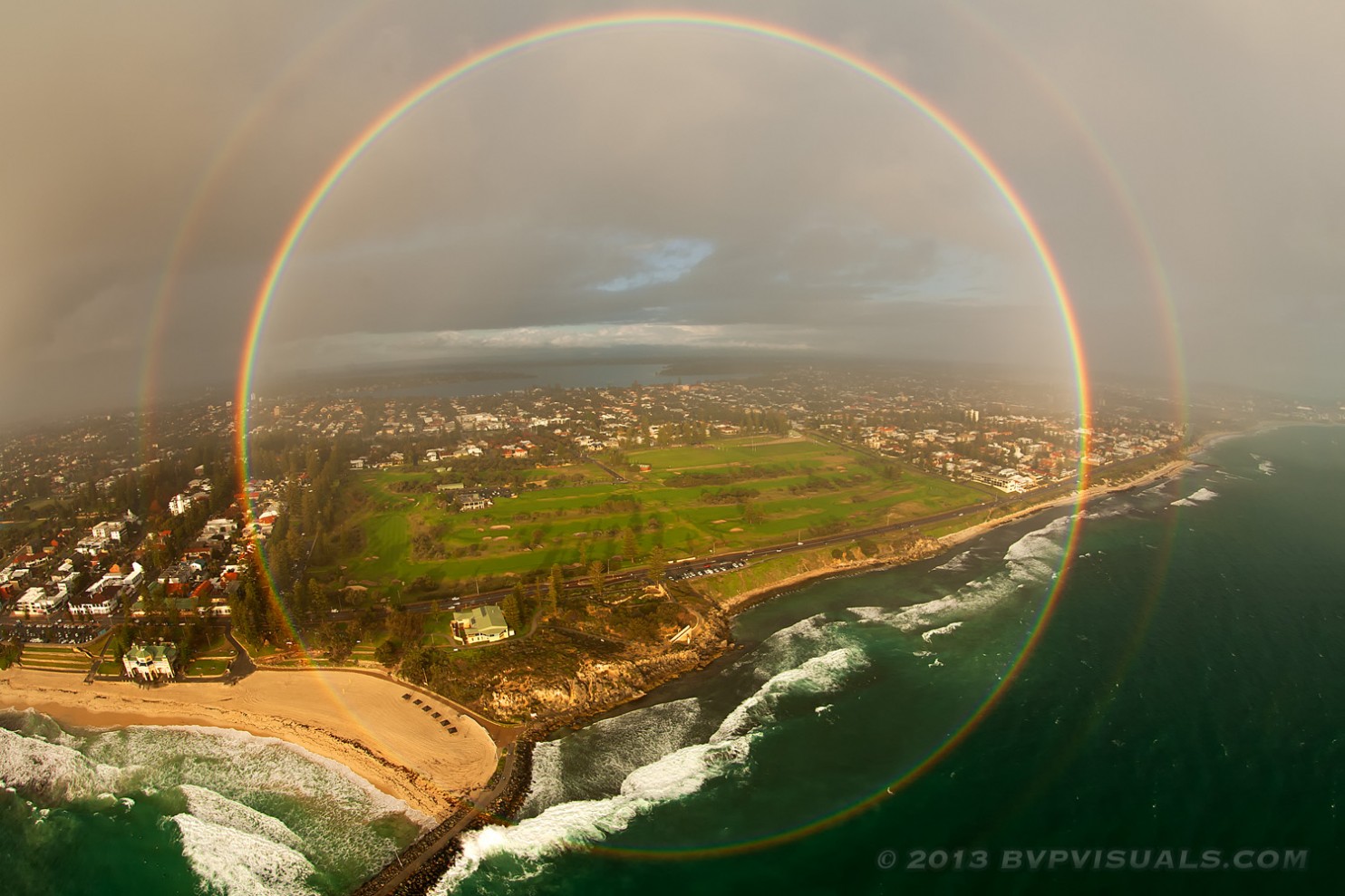
No. A rainbow is at ~41 degrees from the anti-solar point, so it would be a 180-41 = 139-degree halo.
A 180 degree halo would be a straight line
Well, kind of. It would be a line bisecting the sky between the sun and the point opposite the sun. At sunset or sunrise it would pass directly overhead.
A 180 degree halo would be a straight line
No, it would be point of light opposite the sun.
No, it would be point of light opposite the sun.
You are right, I was confusing diameter with radius. That would be a 90 degree halo.
Trailspotter
Senior Member.
The photo has been taken from the roof of the building listed as his address. Adding it to Google Earth also matches the Sun position, suggesting that the photo was taken shortly before it was posted on Facebook at 2:54 PM EST.Fascinating. He also posted this photo:

Also, the resulting horizontal field of view of 83° is consistent with the inner halos being 9°, 18° etc. This is corroborated by a flickr photo, the horizontal field of which deduced from Exif is about 60°:
That's a different assessment from what we arrived at. From Mick's comparison with an earlier photo by Patrick Roddie, we found that the inner outer ring is the 22° halo, and in that case the outer one must be at 28°. But if Les Cowley is right then the inner one is at 18° and the outer one should be the 22°.
My comparison might be a bit off, the non-rectilinear lens used for the time-lapse (note the curved sides of buildings) might be distorting things more than I thought.
CapnPegleg
Member
Rainbows are 42° you can generally only see half of it because the rest would be underground. If you get high enough you can see the whole thing.
M Bornong
Senior Member.
Okay, I finally have to ask.
Circles are 360 degrees, so how can there be a 22 degree circle? The definition for the sun halo says it's 22 degrees from the sun, but it surrounds the sun completely, so what does that actually mean? I get it seems to be referring to distance from the center, but don't understand how it's measured or why it's expressed as a degree.
http://www.atoptics.co.uk/halo/circular.htm
Luckily Patrick has quite a collection of photos from similar locations.
A 22° halo

The multi-halo in a similar location, and more importantly with what seems to be the same camera/zoom. The top of the middle building is the same size in both shots. Time reported as 10:45AM

Overlaying them with no scaling shows that the 22° halo more closely matches the outer halo
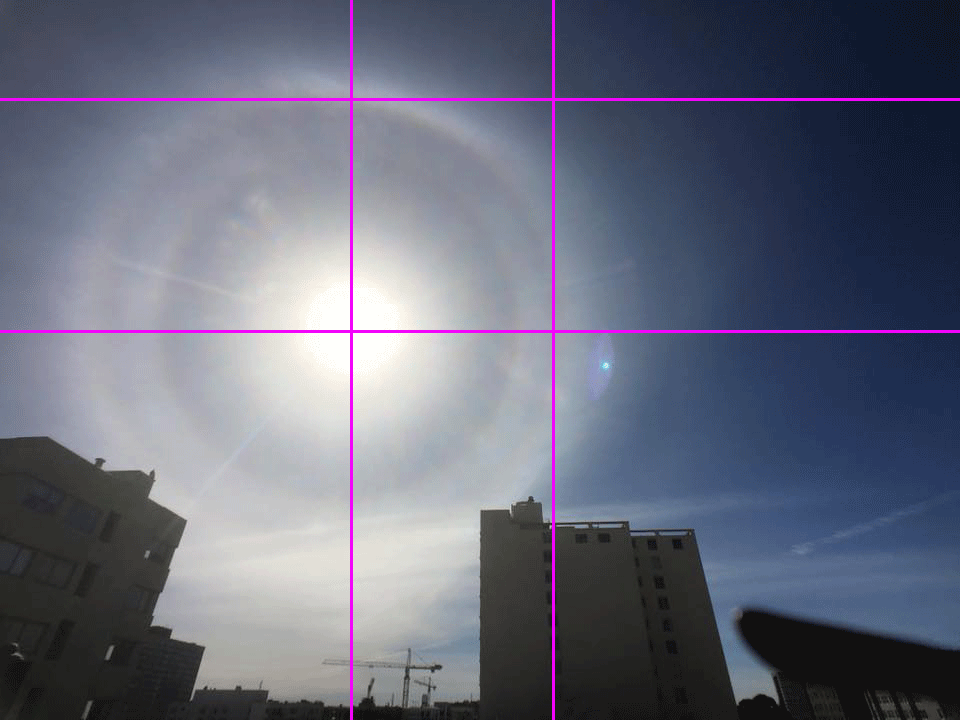
A 22° halo
The multi-halo in a similar location, and more importantly with what seems to be the same camera/zoom. The top of the middle building is the same size in both shots. Time reported as 10:45AM
Overlaying them with no scaling shows that the 22° halo more closely matches the outer halo

skephu
Senior Member.
OK, so then the outer ring is not Scheiner's halo after all. That's better because Scheiner's is too rare.Overlaying them with no scaling shows that the 22° halo more closely matches the outer halo
OK, so then the outer ring is not Scheiner's halo after all. That's better because Scheiner's is too rare.
Yes, I've removed "Scheiner's" from the thread title. It's still a very interesting and unusual halo display though.
Similar threads
- Replies
- 3
- Views
- 888
- Replies
- 3
- Views
- 3K
- Replies
- 45
- Views
- 5K

